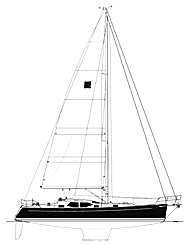Saga 48
Bluewater cruiserr
Back in the mid-1990s, at a time when a lot of boatbuilders were biting the dust, Scotsman Alan Poole decided to start Saga Marine and produce a line of sailboats initially conceived as counterpoints to the overly beamy cruising boats that were dominating the market. Alan approached me to do the designing and I signed on immediately. Pundits gave Saga little chance of surviving. That was 50 Saga 43s ago and 12 Saga 35s ago. The new 48 is the next logical step beyond the Saga 43 and is intended to be a comfy, fast and easy-to-handle "mom and pop" cruising boat.
The hull form borrows the short ends and nearly plumb stem from my Saga 43 and 35, although this time I have chosen to go with more beam. The L/B of the 48 is 3.47 so the 48 is still far from a fatso when you compare it to many other contemporary cruisers, some of which have L/Bs under 3.
A fine entry combined with a waterline length of 43 feet, 7 inches and a D/L of 160 ensures good performance under both sail and power. This design recognizes that most of us end up motoring a lot when cruising. I just had a weekend on Puget Sound of 3-knot tides combined with light, fickle winds. Performance under power is important. I am looking for speed under power of around 9.5 knots. The big, spade rudder is as far aft as I could put it and will give the 48 good tracking characteristics. The keel is a moderately shoal fin-and-bulb type designed more for cruising convenience than blazing upwind speed.
The concept was for a quick cruising boat capable of navigating the ICW with the happy couple snug and cuddly, so I gave the boat a raised, double helm seat and inside steering. The galley is big and that suits me just fine. There is lots of counter space and a very large reefer/freezer unit. The dinette is not raised but extends outboard under the side deck. This dinette is 7 feet, 6 inches long and more than adequate for four to dine in comfort. The two heads share a shower stall. There is a nav station adjacent to the aft head. Note the large hanging locker. The forward stateroom is spacious and features a double berth that is 6 feet wide across its widest point. The plumb stem affords us the volume for a large fo'c'sle and the aft cockpit layout leaves plenty of room for a huge lazarette.
On deck we chose a two-wheel arrangement for the cockpit in order to have a clear walk-through transom opening to the swim step. The wheel areas feature sculpted consoles to house instruments and computer screens. Just like with the other Sagas, we went with a pipe frame bowsprit that houses the ground tackle rollers. There is a foredeck hatch that allows direct access to the fo'c'sle. I like the looks of this boat. If I didn't I would have changed it. I do find it ironic that while I rail against Euro-styling from time to time, my Saga 48 looks more Euro than the Group Finot-designed Beneteau reviewed next. The Sagas, with their truncated ends, have always had a distinct look.
The rig is based on the rigs we did for the other Sagas. There is a self-tacking jib with a single sheet that goes up the mast from the jib track and then down to a coaming-mounted winch. There are tracks for the masthead genoa, which is a light-air or reaching sail. The best way to tack the genoa on this rig is to just bite the bullet and roll it partially or all the way up. You can squeeze it through the small slot without rolling it up, but it ain't pretty. In any wind above 8 knots the tremendous convenience of the self-tacking jib overcomes the small reduction in sail area. There is also a taller rig for those who don't have to worry about going under bridges. The SA/D is 19.98 with the tall rig. This is on the high side for a mom and pop boat, but consider that this boat is designed to be sailed primarily with the nonoverlapping self-tacking jib.

Comments